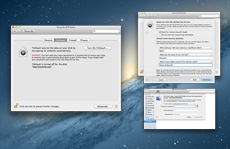
Oh, and a time machine backup of my office data also takes place, along with a SuperDuper clone of the root volume.

Needless to say, each array is backed up to a Netgear ReadyNAS Pro, as well as a Solaris Express server. Most hard disks are WD 2Tb “green” models. For example, enclosure A stores my work-related stuff (in a 3-disk mirror), while enclosure B contains audiovisual stuff: a huge Adobe Lightroom catalog in a two-disk mirror, and my home video projects in another array. So, the setup is as follows: two 5-disk enclosures are directly attached to my Mac, each with an assortment of non-RAID and mirrored arrays, depending on the importance of the data. The OSX86 machine runs beautifuly, with many weeks’ work of uptime, albeit with some trouble which I’ve managed to troubleshoot (see below). Granted, there are some glitches (my MacBook Pro kernel occasionaly panics with the ExpressCard on boot up), but data reliability is not jeopardized as with other chipsets. port multiplication, hot swapping – as well as stability, compared to the newer 6Gb/s offerings from other manufacturers. Based on my (limited) research, this archaic chip from Silicon Image provides much better functionality – e.g. Apparently, even the ExpressCard3/4 variants of the Si3132 chip, which are widely available, work quite well with the latest drivers from Sonnet – last updated on November 29, 2011. It’s attached to my HackPro via a two-port Sonnet Tempo E2P (mini PCIe) card, so some of the information in this post will be specific to this (Silicon Image 3132-based) card.

It is compact, quiet and stylish, plus: the disks can be swapped without the use of special tools/frames, which makes it very convenient. Another very nice enclosure: the Sharkoon 5-bay eSATA/USB box.


 0 kommentar(er)
0 kommentar(er)
